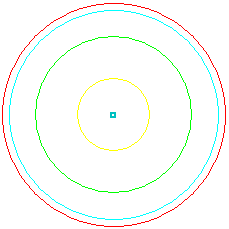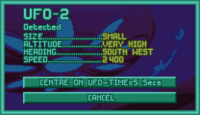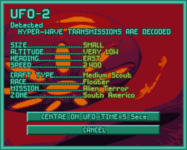Обнаружение НЛО
Объекты пришельцев регулярно появляются в атмосфере Земли (в EU) и бороздят просторы океанов (в TFTD). Для того, чтобы не допустить выполнения ими своих задач, эти аппараты необходимо сбить или захватить в момент приземления. В любом случае, для этого нужно сначала обнаружить НЛО, для чего и служит соответствующее оборудование на базах и летательных/плавательных аппаратах Х-СОМ.
Модули обнаружения НЛО
На базе можно построить три вида модулей, служащих для обнаружения НЛО:
- Малая Радарная Система/Стандартный Гидролокатор имеет радиус обнаружения в 300 морских миль, как сообщается в Уфопедии. Эта цифра выглядит заниженной примерно в 5 раз. В официальном руководстве упоминается радиус в 1500 миль, что больше соответствует наблюдениям.
- Большая Радарная Система/Широкополосный Гидролокатор согласно Уфопедии имеет радиус обнаружения в 450 морских миль, на самом деле он примерно равен 2250 милям. Большие радары покрывают 225% от площади покрытия малых радаров.
- Гиперволновой Декодер/Дешифровщик Передач согласно наблюдениям и данным из таблиц имеет радиус немного больший, чем у Большого Радара - примерно 2400 морских миль. В Уфопедии этих данных нет.
Все летательные/плавательные аппараты X-COM имеют радиус обнаружения в 600 миль. Их можно использовать для разведки зон, удаленных от базы, или как временный заменитель радара, если его строительство еще не завершено.
На стартовой базе уже построен Малый Радар/Сонар. Для повышения эффективности обнаружения вы можете дополнительно построить Большой Радар/Сонар. Из-за бага дополнительные Радары/Сонары на одной базе (сверх одного Малого и одного Большого) не влияют на шанс обнаружения (несмотря на наличие соответствующей графы на экране информации о базе).
Возможность постойки Гиперволнового Декодера/Дешифровщика Передач появляется только после завершения соответствующего исследования: в EU вы должны допросить пойманного навигатора чужих, а в TFTD вам нужно завершить исследование Магнитной Навигации. После завершения исследования вы можете строить Детекторы/Дешифровщики на любой базе.
Радиусы обнаружения
На рисунке ниже изображены радиусы действия каждой системы обнаружения:
- Желтый = Дальность обнаружения летательных/плавательных аппаратов X-COM (на рисунке отмечен диаметр обнаружение 1500 миль, хотя на самом деле он составляет 1200 миль)
- Зеленый = Дальность обнаружения Малого Радара/Сонара (диаметр 3000 миль). Кроме того это максимальная дальность обнаружения базы чужих для летальных/плавательных аппаратов X-COM
- Синий = Дальность обнаружения Большого Радара/Сонара (диаметр 4500 миль)
- Красный = Дальность обнаружения Гиперволнового Декодера/Дешифровщика передач (диаметр 4800 миль)
На практике корабли противника могут оказаться далеко внутри зоны обнаружения до того, как будут обнаружены. Это происходит по ряду причин:
- Попытки обнаружения производятся два раза в час, быстрые НЛО/НПО могут преодолеть значительное расстояние между проверками.
- Малые и Большие Радары/Сонары имеют 10-20% шанс обнаружения вражеских кораблей, попавших в радиус их действия.
- Корабли чужих могут быть обнаружены только после того, как они войдут в земную атмосферу или поднимутся из глубин океана, а это может случиться прямо рядом с базой.
Аппараты X-COM обнаруживают НЛО/НПО, попавшие в радиус обнаружения, со 100% вероятностью.
После обнаружения НЛО/НПО останутся видимыми до тех пор пока они не покинут земную атмосферу или не выйдут за радиус всех активных радаров. Получасовые проверки проводятся и при слежении за объектом, поэтому корабль может выйти далеко за пределы действия радаров до того как исчезнуть с экрана. Это особенно характерно для быстрых кораблей, которые могут пройти до 2500 миль между проверками. НЛО, покидающие атмосферу (или уходящие в глубину) исчезают мгновенно.
Базы чужих могут быть обнаружены только патрулирующими аппаратами X-COM (и, иногда, агентами X-COM в конце месяца). Максимальная дальность обнаружения базы составляет 1500 миль, при этом шанс обнаружения уменьшается с увеличением расстояния. Чем дольше аппарат патрулирует зону, тем больше шансов находящиеся рядом базы.
Калька Радиусов Обнаружения
Вы можете использовать изображение ниже для выбора места для новой базы. Отцентруйте глобус на место, где вы хотите построить базу, снимите игровой скриншот (F12) и скопируйте на него это изображение для того, чтобы увидеть потенциальные радиусы обнаружения (Калька нарисована для скриншотов с разрешением 640x480):
How Radars Function
Each radar/sonar type has a chance to detect any UFO/USO within its range. Detections are performed in the game every 30 minutes exactly on the half hour. (If you are advancing the game an hour or day at a time, you may find the clock jumps forward to exactly a half hour interval whenever it spots a new enemy ship.)
Small Radars/Sonars have a 10% chance of detecting UFOs within their range, and Large versions have a 20% chance. If you have both Small and Large Radars/Sonars built at the same base, their abilities are added together: you will have a 30% chance of detecting aliens within 1500 nm and a 20% chance of detecting them from 1500 nm to 2250 nm.
Despite the "Short Range" and "Long Range" detection bars displayed on each base's Information screen, only one radar/sonar of each type will be used at each base; building additional modules will have no effect.
Hyper-Wave Decoders/Transmission Resolvers have a 100% chance of detecting any enemy ships within their range. Given their superior range and detection abilities, these make the other detection types unnecessary. If you have Small or Large Radars/Sonars in a base which also has a decoder/resolver, you can dismantle them.
"Normal" radars/sonars reveal the approximate size, altitude, heading, and speed of aliens within range. Hyper-Wave Decoders/Transmission Resolvers also display the exact craft type, the alien race onboard, what type of mission the craft is on, and where the mission is to be performed.
Craft-based UFO Detection
All traveling X-COM craft, whether en route or patrolling, can also detect UFOs/USOs within a small range, 600nm. Within this range, craft can detect enemies 100% of the time. However, given the half-hour detection update intervals and craft speed, aliens can often pass within range of an X-COM craft without being spotted. All types of X-COM craft, whether Skyrangers or Avengers, have the same UFO detection chance and the same detection radius, whether moving or patrolling.
Faster craft may sometimes appear to have a shorter detection radius, as they can travel great distances between detection updates, so they often only detect alien ships when right on top of them, or even having passed them already. The effective detection range can also appear shorter or longer, depending if the UFO/USO is moving closer or moving away at the moment of detection.
If an alien vessel moves out of range of your base-based detection systems, you may be able to resume tracking by sending one of your ships to where you believe the enemy to be (based on its speed and direction).
Similarly, by launching an immediate Interception aircraft mission, it may be possible to maintain tracking of a UFO/USO long after it has moved outside range of ground-based detection - provided the aircraft can keep within 600nm of the target.
Alien Base Detection
All X-COM craft are also capable of detecting alien bases. In fact, this is the only way to discover them: they will not show up on any base radar, including Hyper-Wave Decoders. (However, "X-COM agents" will sometimes report the discovery of a base during X-COM's Monthly Report; see Locating an Alien Base.) In order to discover an alien base, an X-COM craft must patrol within 1500 nm of the base's location. The nearer the craft, the sooner the base will be discovered. Patrolling immediately above a base will reveal it almost immediately; patrolling 1500 nm away, the base may take one hour to discover, or several hours.
Bases can only be discovered by patrolling craft. An X-COM craft could fly over an alien base repeatedly and never discover it until it began patrolling in the area.
It is frequently possible to deduce where an alien base is by the pattern of UFO traffic. The primary mission of Supply Ships/Fleet Supply Cruisers is to supply alien bases; wherever they land, a base is likely to be found. When a base is first being built, four UFOs/USOs (a scout, two supply ships, and a battleship/dreadnought) will converge upon the same area and mill around for a while. (UFOs engaged in an Infiltration mission will display similar behavior involving five ships.) In UFO, the alien race found at a base will always be of the same type as the race found on the initial ships (or the supply ships which subsequently show up at regular intervals), while in TFTD all bases are manned by the same species.
UFO Activity Graph
Finally, the UFO/USO activity graphs, accessed from the Geoscape, can act as a sort of "MUFON" (Mutual UFO Network: a civilian group dedicated to the observation of UFOs/USOs), allowing you to see activity that your radars/sonars cannot.
Turn on all the specific areas/seas and countries/zones and check them periodically. If one of the lines for the current month has changed, that means alien activity is occurring there. The country/zone graph usually provides more useful info than the area graph, though you should check both periodically. On occasion the area graph reports activity that is not reflected on the country graph -- in that case, keep an eye on it since more activity is likely to folllow.
The graphs are updated every half hour. Although tedious, checking them every 3-6 hours can give you enough time to detect and intercept a UFO/USO while it is still on Earth. Using this method, it's possible to play the game with no radars/sonars, at least for the first few months. After that, UFO/USO activity becomes too intense and the graphs lose their resolution, but by that time you should have decoders/resolvers already built, or on the way.
Be sure to only look at the current month's activity when trying to track current UFO activity. To make it easier to spot changes, you can write down the activity figures for each area and compare them with the current figures any time you think they've changed.
Checking the graphs less often will not allow you to do realtime interceptions, but it will tell you where to expect trouble, as scout activity always precedes larger craft on a related mission. The graphs are especially useful for discovering where Alien Bases have been built, as they generate frequent Supply Ship activity. Knowing where the aliens have been focusing their attention also gives you a good indication of where to build additional X-COM Bases.
Note that these graphs are actually showing the aliens' score; this is why even later in the game it will be possible to see where the aliens are being able to complete missions, even if individual UFO/USO flight plans will be swamped.
No matter how wide or powerful your detection network eventually becomes, if you ever find yourself going through any quiet lengths of time where little to no alien activity is picked up, you should make a habit of checking the graphs. Though they will not provide you with exact locations, you will still get a good indication of the region that needs to be patrolled.


